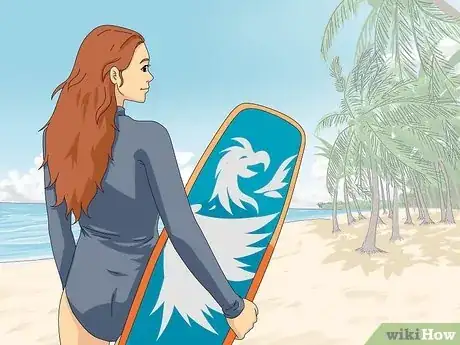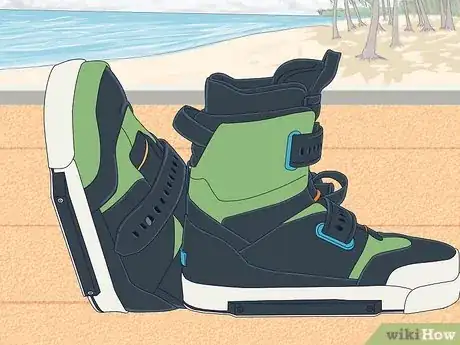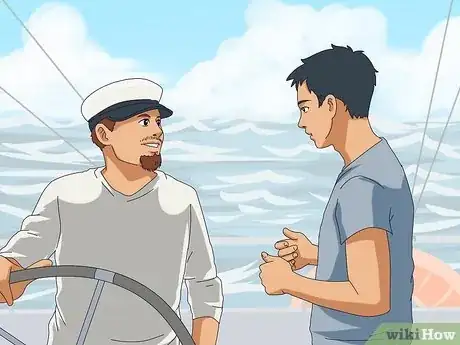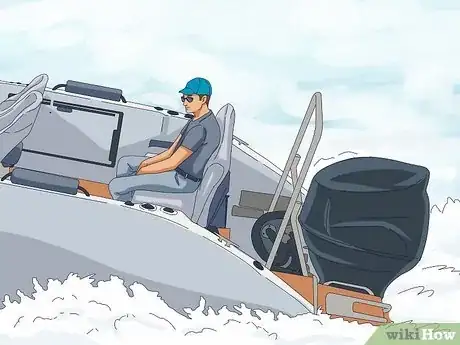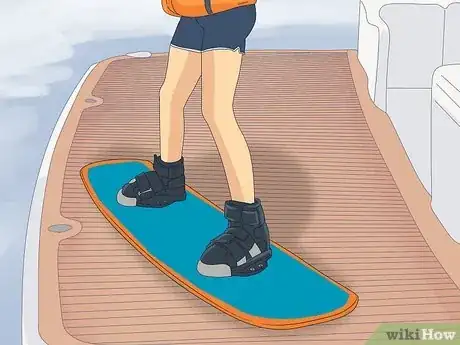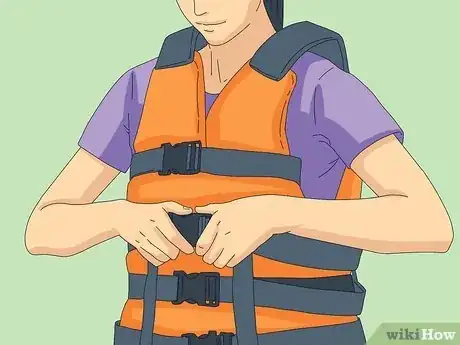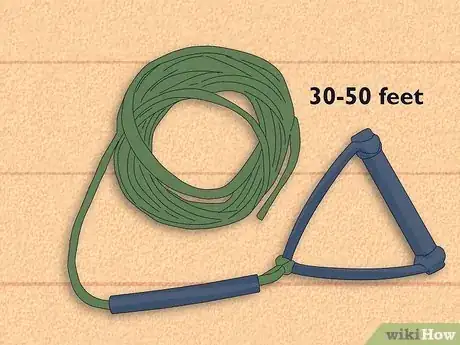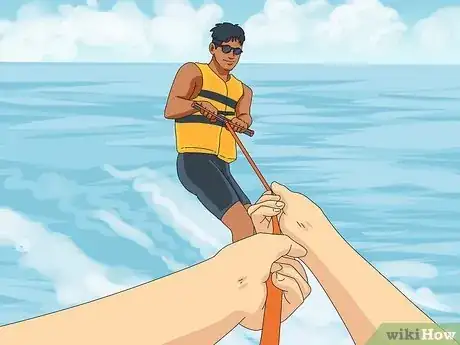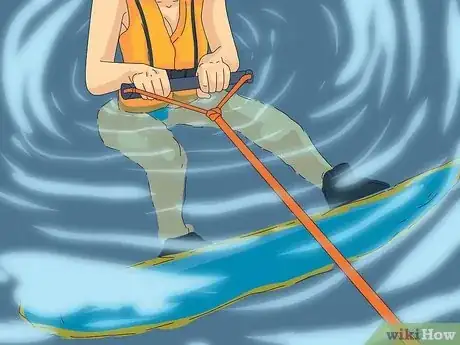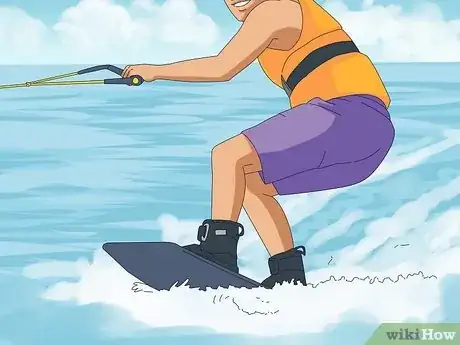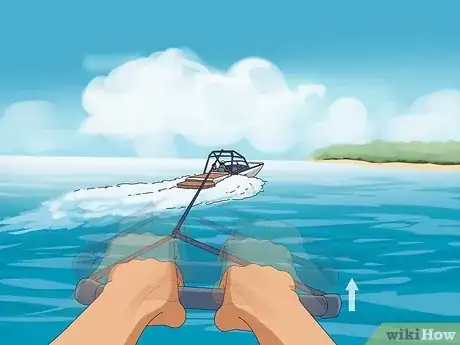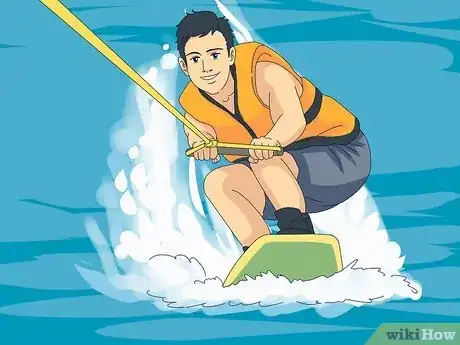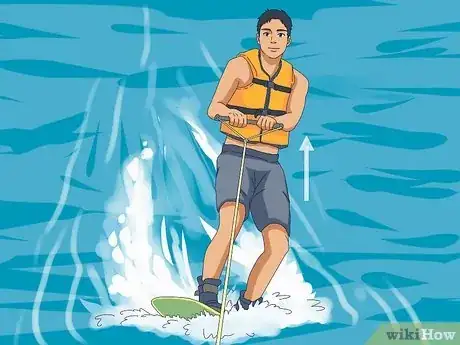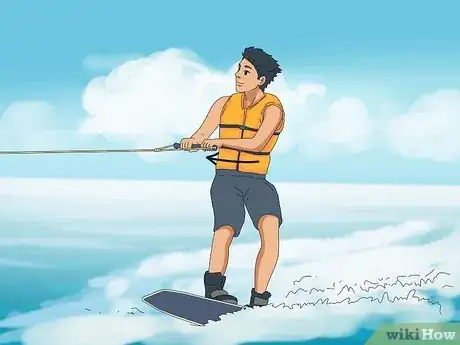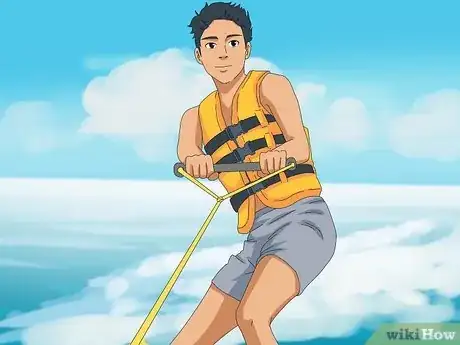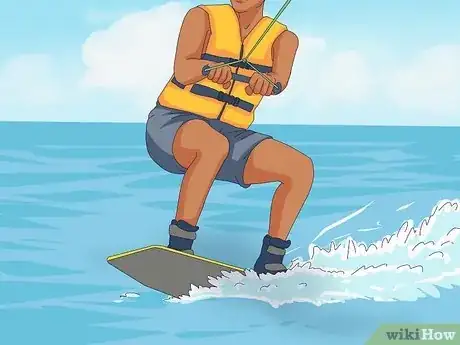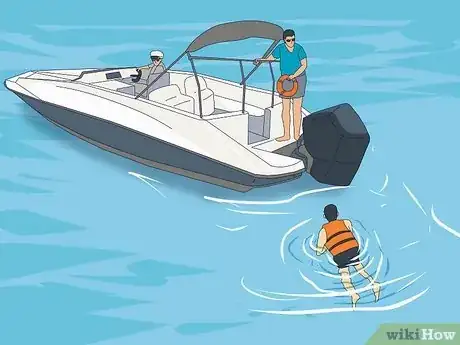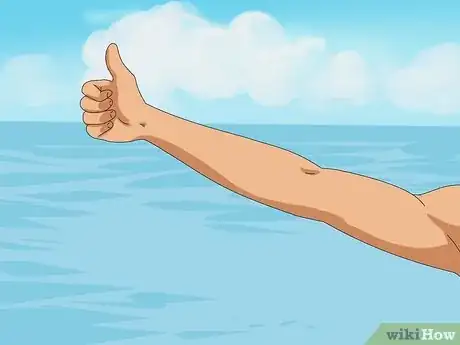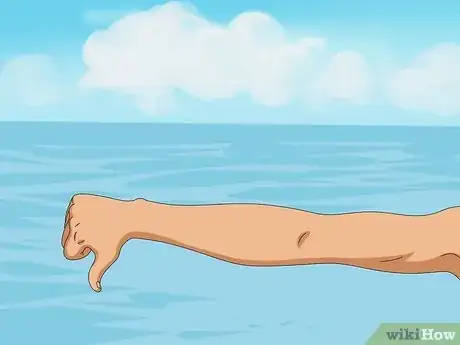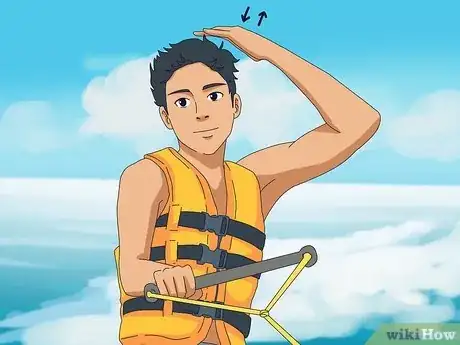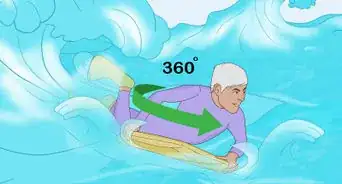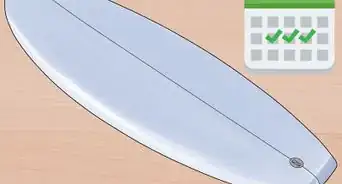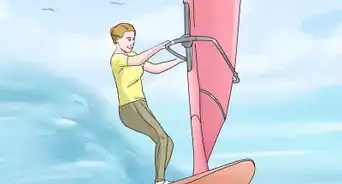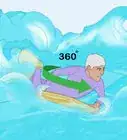This article was co-authored by wikiHow staff writer, Kyle Hall. Kyle Hall works on the content team at wikiHow. He helps manage our team of editors and creates content for a variety of wikiHow projects. Kyle continually looks for new ways to improve the content at wikiHow and make it more helpful and enjoyable for readers. He graduated from Eckerd College in 2015, where he majored in Political Science.
There are 9 references cited in this article, which can be found at the bottom of the page.
This article has been viewed 276,057 times.
Learn more...
Wakeboarding is a fun, exhilarating water sport that doesn’t take long to learn. That's good news if you're a beginner -- it means you can get up on your board and start gliding across the wake in no time. You just need to get the right gear and nail down a few wakeboarding basics first before you start doing flips and tricks in the air.
Steps
Getting Set up to Ride
-
1Rent or buy a beginner’s wakeboard. Look for a longer wakeboard; longer wakeboards are easier to control and their landings are softer than a shorter board. The size of the board will also depend on your weight. The more you weigh, the longer your wakeboard should be.[1]
- Get a board with a continuous rocker for a smoother, easier ride. You’ll know it has a continuous rocker if when you’re looking at it from the side it’s in the shape of one continuous curve from tip to tail.[2]
-
2Get a pair of wakeboarding boots. Wakeboarding boots, also known as bindings, go on your feet and hook onto your wakeboard so you’re held in place during your ride. Look for a stiffer, less flexible pair of boots for when you’re just starting out. It will be easier to balance and steer the board if your ankles are tightly locked into place.[3]
- Your boots will screw into the tiny holes built into your wakeboard. Not all bindings attach to a board the same way, so check the instructions that came with your boots before you attempt to attach them to your board.
Advertisement -
3Talk to the boat driver. Make sure they understand that you’re a beginner and ask them to take it slow with you. A boat driver should never speed with a beginner wakeboarder. Because you’ll likely fall several times during your first few go’s, remind the driver to slow down before turning around to come retrieve you so you don’t get caught in any choppy waves.[4]
-
4Designate someone to be the spotter. The spotter is someone on the boat (other than the driver) that keeps an eye on things while you’re wakeboarding. The spotter should alert the driver whenever there’s nearby boats or objects or if they see you fall down during your tow.
-
5Decide which foot you want to face forward. If you’re regular or goofy footed in other board sports like snowboarding and surfing, you’ll probably be the same in wakeboarding. If you’re not sure, think about which foot you use to kick a ball with and place that foot in the back. You want your non-dominant foot to face forward.[5]
- If you’re regular footed, your left foot faces forward on the board.
- If you’re goofy footed, your right foot faces forward on the board.
-
6Put on a life jacket before you get in the water. A life jacket will help you stay afloat while you’re waiting to get towed, and it can protect you from serious injury while you’re wakeboarding.[6]
-
7Use a short rope during your first few tows. A shorter rope will position you in the narrower part of the wake, making it easier to stand on your board. Use a rope that’s between 30-50 feet (9-15 meters) long.
Practicing with Your Board
-
1Do practice drills on land. Sit on the ground with your knees bent and your feet flat on the ground in front of you. Stretch out your arms straight ahead with your knees in between, as if you’re holding onto a tow rope. Have someone grab your hands and pull you up to a standing position, as if a boat is pulling you up onto your board via the tow rope.[7]
- The key to the land drills is learning how to relax when you’re being pulled up to a standing position. Don’t try to stand up on your own or fight the pull. Let the person pulling you up do all the work.[8]
-
2Practice getting in the water on your board. Sit on edge of the boat’s swim platform and slide your feet into your boots. Once you’re strapped in, place your board in the water and slowly slide off the edge of the swim platform until you’re off the boat. Your board should be floating on its side with the front edge at the water’s surface. Bend your knees so they’re touching your chest and stretch your arms out in front of you like you’re holding onto a tow rope handle.
-
3Do practice drills in the water. Practice with someone like you did on land, but this time strapped into your board in the water. Have someone stand on the swim platform of the boat, each of you holding on to opposite ends of a tow rope. Have them pull you in as close to the swim platform as possible via the tow rope and then pull you up onto the swim platform so that you’re standing on your board.[9]
- If you tense up or fight the pull, have the person on the swim platform release you back into the water. Keep repeating the drill until you’re able to relax and get pulled up onto the platform without resisting.[10]
Getting up on Your Board
-
1Grab hold of the tow rope handle after the driver throws it in the water. Relax your body and wait for the driver to get the boat into position.
-
2Keep your knees bent and your arms stretched out in front of you. Your knees should be close to or touching your chest. Make sure your body is relaxed. The front edge of the wakeboard should be perpendicular to the tow rope and just above the surface of the water.[11]
-
3Signal to the driver that you’re ready to be pulled up. Most experienced wakeboarders will raise a hand to signal the driver, but as a beginner, letting go of the tow rope with one hand may cause you to lose your grip. Instead, hold onto the tow rope handle with both hands and raise it into the air when you’re ready to begin.
-
4Let yourself be pulled up to a crouched position on your board. Once the boat starts moving forward and you feel the tow rope begin to pull, let yourself be pulled up onto your board like you did in your practice drills. Keep your knees bent and stay relaxed. Don’t rush to stand up. Moving too quickly may cause you to lose your balance.[12]
-
5Raise yourself to a standing position gradually. Remember that the boat is increasing in speed, so you want to get yourself positioned in a balanced, steady stance. Keep your knees bent slightly and not locked. Your arms should still be stretched out in front of you. You can lock your elbows around your knees if you face trouble getting up onto the board.[13]
-
6Bring the tow rope handle around to your side. Line the handle up with your leading hip and turn your head to look over your leading shoulder.[14]
Riding the Wake
-
1Look straight ahead. Avoid looking down at your board. You might lose balance or cause the front of your board to dip and throw you into the water.[15]
-
2Lean into your heels and toes to steer your board. Avoid turning the actual board to steer as you’ll likely fall. Applying pressure to your toes (the front edge of the board) and your heels (the back edge of the board) will cause your board to carve through the water and turn.[16]
-
3Keep the tow rope handle in line with your hip. If you catch yourself raising the handle or holding it up to your chest, steadily move it back down. Holding the handle high up when you’re wakeboarding may cause you to fall.[17]
-
4Wait for the boat driver to retrieve you if you fall. Falling into the water on a wakeboard can be painful, but it’s important not to panic. Once the driver has turned the boat around, signal to them that you’re OK. If you want to try again, wait for the driver to put the boat in neutral and then grab hold of the tow rope handle. Get back into starting position and signal to the driver that you’re ready to start.[18]
Using the Proper Hand Signals
-
1Give the boat driver a thumbs up if you want to go faster. Wait until you’re up on your board and the driver has stopped accelerating. Hold your thumb up steady if you want a smaller increase in speed, and wave it up and down if you want a bigger increase in speed.[19]
-
2Give the boat driver a thumbs down if you want to go slower. Make sure your hand is far enough away from your body that the driver or spotter can see it. Do a steady thumbs down for a slight decrease in speed, and a waving thumbs down for a larger decrease in speed.[20]
-
3Pat the top of your head when you’re ready to stop. Once you’re confident the driver or spotter saw you, drop the tow rope handle. Wait for the driver to turn around to retrieve you.[21]
Community Q&A
-
QuestionHow do I get off the dock if I am on a line pulley system and I start sitting?
 Community AnswerYou should start sitting in the water so that you are floating on your back with your board in front of you. Make sure you can see ahead of you and that the cable is on top of your board, not underneath it. When the cable is about to start pulling, bring your leading foot out of the water more, so as the cable tightens you are pulled out of the water until you are squatting over your board with your leading foot facing the cable course. Once you have gained a steady speed and balance, stand in the upright position with your knees bent and your center of balance over the center of the board.
Community AnswerYou should start sitting in the water so that you are floating on your back with your board in front of you. Make sure you can see ahead of you and that the cable is on top of your board, not underneath it. When the cable is about to start pulling, bring your leading foot out of the water more, so as the cable tightens you are pulled out of the water until you are squatting over your board with your leading foot facing the cable course. Once you have gained a steady speed and balance, stand in the upright position with your knees bent and your center of balance over the center of the board. -
QuestionHow do you switch the front foot with the back foot when you're wakeboarding?
 Community AnswerFirst you should make sure your weight is evenly distributed between both of your feet on the board. Then bring the tow rope handle away from your leading hip and hold it out in front of you. Your board will begin to turn and your feet will be facing forward, in the direction of the boat. Bring the tow rope handle around to your other hip. Your other foot should now be facing forward on your board.
Community AnswerFirst you should make sure your weight is evenly distributed between both of your feet on the board. Then bring the tow rope handle away from your leading hip and hold it out in front of you. Your board will begin to turn and your feet will be facing forward, in the direction of the boat. Bring the tow rope handle around to your other hip. Your other foot should now be facing forward on your board. -
QuestionWhat do I tie the tow rope to on the boat?
 Community AnswerYou should invest in a wakeboard tower (a tower that attaches to your boat that you tie the tow rope to) for an optimal wakeboarding experience.
Community AnswerYou should invest in a wakeboard tower (a tower that attaches to your boat that you tie the tow rope to) for an optimal wakeboarding experience.
Warnings
- Always wear a lifejacket when wakeboarding.⧼thumbs_response⧽
References
- ↑ https://mpora.com/wakeboarding/wakeboarding-beginners-guide-techniques-tips-new
- ↑ https://www.evo.com/what-is-a-rocker-and-how-does-it-affect-wakeboard-performance
- ↑ https://www.evo.com/guides/how-to-choose-wakeboard-boots-and-bindings
- ↑ http://www.boatingmag.com/learning-how-to-wakeboard#page-19
- ↑ https://mpora.com/wakeboarding/beginners-wakeboarding-tips#SKwzHTk4ZBvsMFsB.97
- ↑ http://www.wakeboardingmag.com/how-to-choose-a-life-jacket
- ↑ http://www.boatingmag.com/learning-how-to-wakeboard#page-13
- ↑ http://www.boatingmag.com/learning-how-to-wakeboard#page-13
- ↑ http://www.boatingmag.com/learning-how-to-wakeboard#page-13
- ↑ http://www.boatingmag.com/learning-how-to-wakeboard#page-13
- ↑ https://coolerlifestyle.com/features/beginners-guide-to-wakeboarding.html
- ↑ https://coolerlifestyle.com/features/beginners-guide-to-wakeboarding.html
- ↑ https://coolerlifestyle.com/features/beginners-guide-to-wakeboarding.html
- ↑ https://coolerlifestyle.com/features/beginners-guide-to-wakeboarding.html
- ↑ https://mpora.com/wakeboarding/beginners-wakeboarding-tips#SKwzHTk4ZBvsMFsB.97
- ↑ https://coolerlifestyle.com/features/beginners-guide-to-wakeboarding.html
- ↑ https://mpora.com/wakeboarding/beginners-wakeboarding-tips#SKwzHTk4ZBvsMFsB.97
- ↑ http://www.boatingmag.com/learning-how-to-wakeboard#page-21
- ↑ http://www.boatingmag.com/learning-how-to-wakeboard#page-21
- ↑ http://www.boatingmag.com/learning-how-to-wakeboard#page-21
- ↑ http://www.boatingmag.com/learning-how-to-wakeboard#page-21
About This Article
To wakeboard as a beginner, start by renting or buying a beginner’s wakeboard, which is longer and easier to control. Then, choose a pair of stiffer, less flexible boots to help you keep your balance. Next, do practice drills on land where you sit on the ground and have someone grab your hands and pull you up to a standing position. Once you’re in the water, grab the rope, keep your knees bent, and let the boat pull you up to a crouched position on your board. Finally, stand up slowly and ride the wake! For more tips, like how to signal to the driver that you want to go slower or faster, read on!
